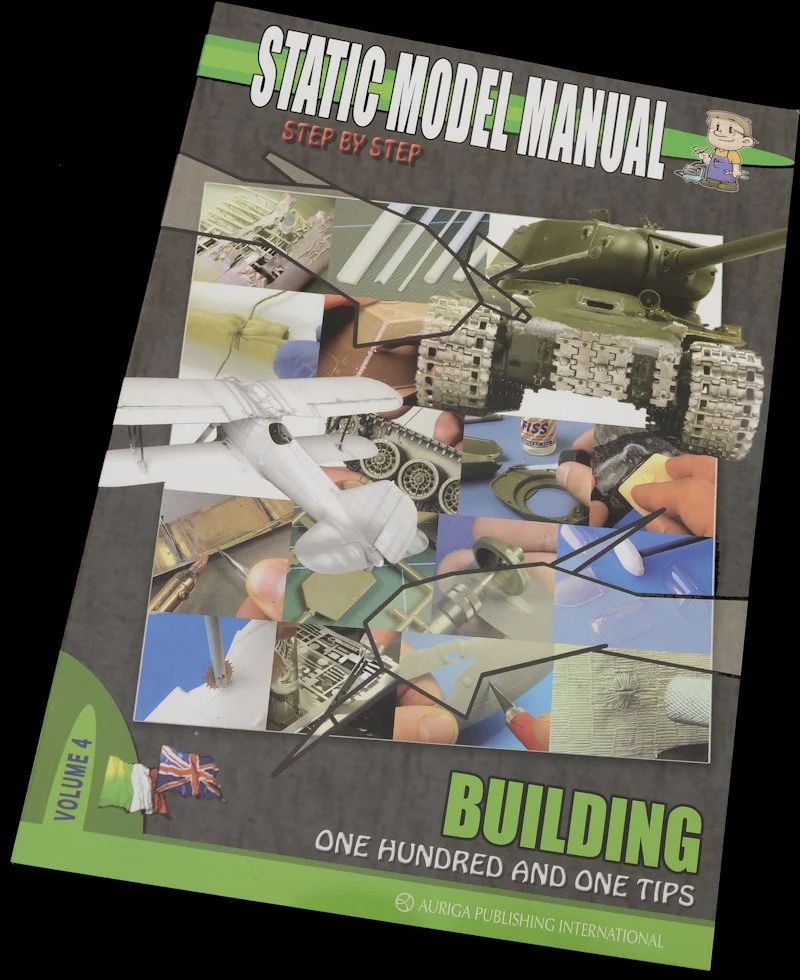We were
lucky enough to look at the number seven in the Static Model
Manuals from Auriga Publishing last month – it showed how to
best paint and weather your models and no doubt it would be a lot of help to a
many modellers out there – this book – number four in the series shows you just
how start at the basics – and how to advance to the higher echelons of model
making skill – but is it useful to the average modeller? Let’s have a look in
our review…

Static Model Manual Volume 4 – Building – One hundred and One Tips
By
Alessandro Bruschi
Auriga
Publishing international
Duel
English/Italian Languages
113 pages
Full
colour photographs throughout
€ 22.90 +
P&P Directly
at this link
This book
is the predecessor to the painting techniques book we read and reviewed last month. I can say the those
two books we have already reviewed were excellent and massively helpful to all
modellers we thought – so we had high hopes for this issue – number in the
series which focusses on the very start of our craft through to customizing and
scratch building using different methods - great! So we naturally were looking
forward to reading this book.
Physically
this book is a shiny softcover A4 portrait format packed with dual text in both
Italian and English languages. The pages inside are of a quality thick magazine
style feels and the pictures which fill the book to the brim are well shot and
well lit.
Now I don’t
know if there are indeed one hundred and one tips in this here book – but it
seems like there are! One hundred and fourteen pages are in a dual Italian and English
language set apart by bold and regular type. The writing is good and apart from
missing my cue sometimes and trying to read Italian before realizing what I was
doing I think it works well.
The text
is easy to read and the subjects are incredibly diverse. Most of the tips take
up a page or a little more each in instruction and some are more of a breakdown
of what you might want to use or modify to use in a situation or to make
something. The book starts off with the basics of what you might need to make a
simple model – how and where to source them, and how to develop the finesse to
use them on just the right way. Diagrams and arrows showing which way to use
tools and materials.
Gradually
as you go through the book you go from the basics of cutting, filling and
gluing your kit to making extra details, extra details on the original model to
make them more realistic to later making your own parts. I think this is a
great book for not only the regular modellers but child modellers as the
writing is basic enough (and not up it’s own bum) but the more experienced guys
will get something out of this too I guarantee it.
Not only
is there plenty of text in this magazine but there are many instances where the
author explains what he is talking about in helpful comparable tables,
data charts, boxed suggestions, and little mottos to live by that are often
something you may not have thought about.
Interesting
to note is the adaptation of power tools to the modeller’s workbench and jut
how to use them without destroying the plastic model. Punch and die kits,
drills and polishing tools to what seems at first are more complicated tools
like Vac-forming machines are mentioned.
Making
specialized surfaces like the anti-slip coating on many modern and some older
vehicle as well as the many types of Zimmerit coating are talked about with
helpful pictures of how to make the tools to create this almost artist effect.
Making wood into smaller scale wooden pieces and fabricating your own wood from
plastic are in here as well. We also look at making cloth and canvas from
plaster and the way to perfect the look and thickness of Perspex on cars,
trucks and armoured vehicles. This was really starting to feel like a book even
the big boys would get something from. We look at simulating damage on vehicles
and especially armour using soldering irons and while we are on it using all
types of aftermarket wheels and tracks for tanks is demystified.
Lastly we
get into some advanced modelling which could take your kits to the next level.
Using silicone moulds to make the parts you need to add to or just to make more
of certain bits like spare wheels or ordinance or spare engines, you learn in
this section using straight pouring techniques and pressurised moulding just
how to cross this which is one of the last frontiers in model making.
Maybe the
only thing missing in this book is the new technology of 3D
printing – this I suppose could well be covered in it’s own publication later
on. Maybe using CAD to make your own models is another good thing for an “Advanced”
book further down the line.
Auriga
Publishing’s titles in this series we have looked at so far are essential
companions, and even these earlier books in the series are great o have to read
thru in case you hit a problem or need to know more about a subject or want to polish up on the newer advanced and obscure techniques we as modellers hope to prefect in our craft. . I would think there are questions about the most basic of techniques in here that you have never thought of.
This is
another great tittle and you all should read it!
Adam
Norenberg
Thanks
to Auriga
Publishing international for sending us this book to read and
review.







